S&P Global Offerings
Featured Topics
Featured Products
Events
S&P Global Offerings
Featured Topics
Featured Products
Events
S&P Global Offerings
Featured Topics
Featured Products
Events
Banking & Capital Markets
Economy & Finance
Energy Transition & Sustainability
Technology & Innovation
Podcasts & Newsletters
Banking & Capital Markets
Economy & Finance
Energy Transition & Sustainability
Technology & Innovation
Podcasts & Newsletters
S&P Global Offerings
Featured Topics
Featured Products
Events
Research — April 22, 2025
By Zain Tariq and Nathan Stovall
US banks' net interest margins are poised to expand as funding costs move lower, while earning assets mature and are replaced with higher-yielding loans and securities. But the Trump administration's broad suite of tariffs will serve as an overhang on the economy, drive credit costs higher and prevent earnings from growing in 2025.

Bank earnings grew in 2024 as net interest margins recovered, while credit quality remained stable. Earnings were expected to grow even more rapidly in 2025 due to declining funding costs and the maturation of lower-yielding pandemic-era assets, allowing for margin expansion. Margins are still expected to expand, but waning consumer sentiment and heightened tariff-related anxiety in the business community are likely to slow growth, reduce investment activity and increase delinquencies. Economic uncertainty may also prompt banks to build loan loss reserves, hindering earnings growth in 2025.

Click here to access the US Bank Market Report.
Click here to access data exhibits and the US banking industry's projections template.
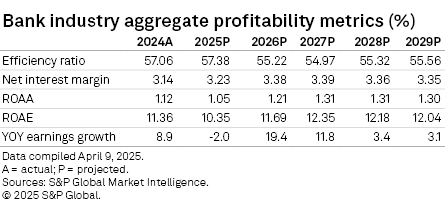
Deposits remain true value of the franchise
Deposit costs declined in the fourth quarter as the impact of Federal Reserve rate cuts began to take effect.
As short-term rates moved lower, banks became far more competitive with alternatives in the Treasury and money markets. The difference between the average fed funds rate and the industry's cost of deposits narrowed further in the fourth quarter of 2024 to the smallest gap recorded since the third quarter of 2022, when the Fed was still early in its tightening campaign. That gap should narrow modestly in 2025 as banks seek to lower their deposit costs while staying competitive with higher-yielding alternatives to grow their deposit base.
A key driver of deposit costs will be the maturity schedule of certificates of deposits. Most institutions have significantly increased their reliance on CDs for funding since the Fed started raising short-term rates early in 2022. Many CDs carry one-year terms, so institutions might not feel significant pricing relief until CDs originated before the Fed pivot in September mature. At the end of the fourth quarter, the bulk of CDs were set to mature in the next year, with 41.5% of all CDs maturing or repricing in the next three months, while 87.2% of CDs were set to mature in the next 12 months. At the end of the fourth quarter of 2024, CDs maturing in the next three months equated to 6.2% of the industry's deposits, while CDs maturing in the next 12 months equated to 13.1% of the industry's deposits.
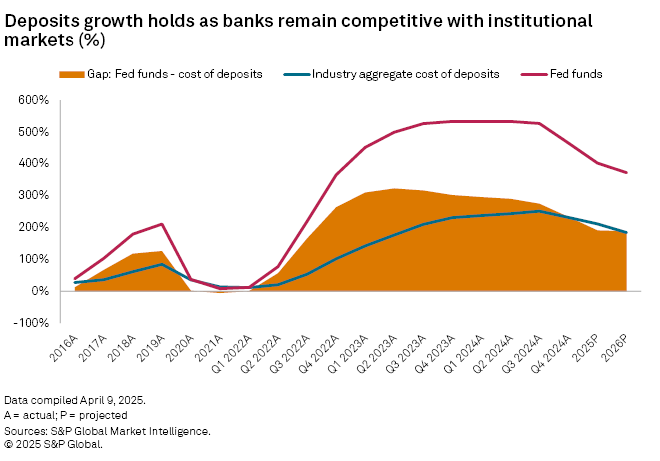

When those CDs mature, most banks will have to meet market rates to retain the deposits. CD rates began declining late in the third quarter and far fewer institutions are offering the products at rates over 4%, but there has been less movement around the 3.5% level. The number of banks marketing one-year CDs over 3.5% included 1,075 institutions as of April 4, 2024, down slightly from 1,134 as of Dec. 27, 1,266 as of Sept. 27 and 1,289 as of Sept. 6.
We expect deposit costs to decline throughout 2025 as higher-cost CDs roll off banks' books. Weaker loan growth should also reduce banks' funding needs and let them keep moving deposit costs incrementally lower. Deposits should grow further, but funds will also continue to shift out of non-interest-bearing deposits — banks' most prized source of funding.
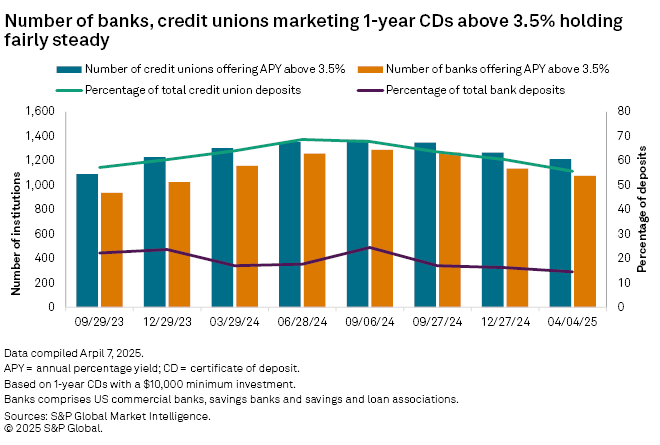
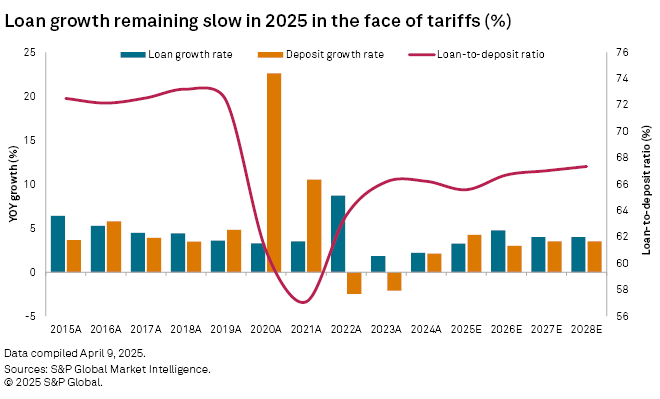
As deposit pricing remains competitive with alternatives in the Treasury and money markets, we anticipate healthy deposit growth in 2025. Although our baseline scenario projects growth, it could be even stronger if new trade policies continue to weigh on consumer and business sentiment, potentially driving a flight to banks' safety.
Loan growth, meanwhile, is expected to remain relatively weak as sentiment wanes and borrowers digest new trade policies that could change the cost of operating their businesses and households. Banks reported far stronger loan pipelines early in 2025, but that appetite has yet to turn into reality. While we expect some of those plans to come to fruition, the emergence of tariffs not seen in 100 years is likely to have a chilling effect on business activity in the near term even if the trade policies do not remain in place for a prolonged period. Many banks are expected to tighten their lending standards and target their most creditworthy borrowers, resulting in slower loan growth.
Credit trends continue to normalize but tariffs could spur higher losses
Banks' credit costs increased in 2024 as their consumer segments faced financial strains and higher borrowing costs, while institutions recorded losses on commercial real estate credits that originated at far lower rates.
While the worst fears of potential bank credit quality deterioration eased heading into 2025 and valuations recovered significantly, talk of a potential recession in the aftermath of tariffs has brought concerns over credit deterioration back to the forefront. Many economists warn that broader tariffs could lead to higher prices for consumers and businesses, potentially leading to a recession.
Our baseline scenario does not include that possibility but assumes that, at least in the near term, trade tensions will slow economic growth, reduce corporate investment and put additional strain on consumers, particularly lower-income households that spend a disproportionate amount of their income on goods impacted by tariffs.
Consumer delinquencies have steadily risen from pandemic-era lows. Consumer savings rates jumped during the pandemic due to stimulus payments and expanded unemployment benefits that allowed consumers to accumulate more than $2 trillion in excess savings. Despite lasting longer than many economists expected, those savings were finally exhausted in the late summer of 2024. Savings served as a buffer against the impact of rate hikes, but their absence likely will be felt over the coming quarters.
Commercial real estate (CRE) delinquencies have also risen off historically low bases, increasing for nine straight quarters to the highest level in nearly a decade. That deterioration has drawn considerable attention, as some CRE borrowers face a double whammy of lower cash flows due to the rise of hybrid work and higher debt service stemming from increases in interest rates over the last few years.
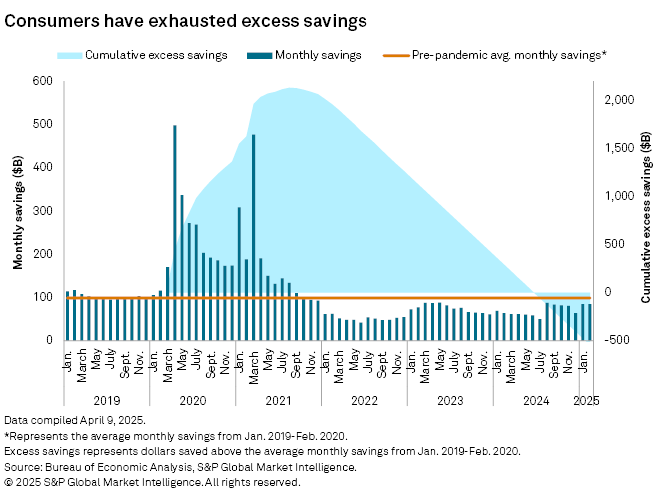
While not all CRE credits are equally affected, loans tied to office properties are the most threatened. The subcategories of that asset class also show distinctions, with premier office buildings — defined as the 7% of highest-quality buildings based on CBRE research — considerably outperforming other office properties.
Banks have increased reserves against their CRE portfolios, particularly related to office credits, with large banks building reserves to 8% or more of their office portfolios. CRE portfolio losses have also risen but remain well below levels witnessed during the Great Recession.
CRE borrowers' mettle will be tested as they seek to refinance maturing credits. Given the increase in interest rates, borrowers may find it harder to access credit or at least face a significantly higher debt service. But CRE losses are likely to be spread out over time.
Rates are unlikely to decline enough to leave borrowers with the same debt servicing costs as before the Fed's tightening cycle. Given the shift to hybrid work, some properties associated with those credits are also producing weaker cash flows.
We expect related refinancing challenges to result in defaults and higher loss content in 2025, with net charge-offs continuing to rise from benign levels. We expect loss content to linger as banks provide borrowers with extensions in the face of some maturity walls.
Many banks have already set aside considerable reserves for the most troubled projects. Reserves rose to 1.75% of loans in 2023 from 1.59% in 2022 and held steady at 1.75% of loans by year-end despite intense regulatory and investor scrutiny of banks' credit quality. While we expect net charge-offs to rise significantly in 2025, losses and the reserves required to fund them should serve as a modest headwind to earnings rather than a severe downturn.
We expect provisions to rise to 26.5% of net revenue in 2025, up from 21.1% in 2024 and 20.9% in 2023. On average, from 2013 to 2019, banks' provisions equated to 14.6% of net revenue.
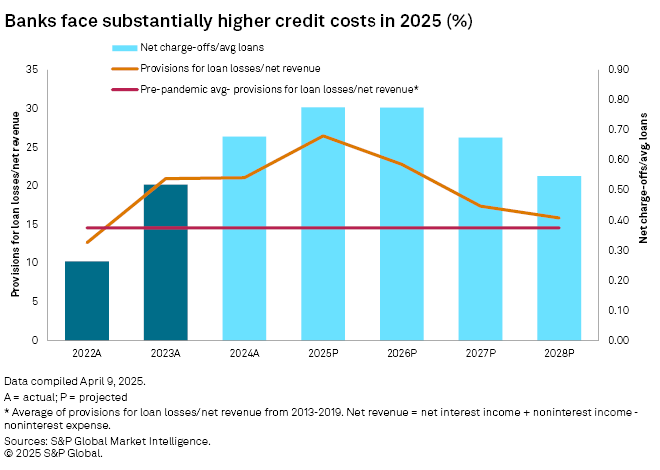
Looking ahead
The fundamental environment heading into 2025 was favorable for US banks, punctuated by improving net interest margins, relatively benign credit quality trends and stronger valuations that gave institutions more options to pursue restructuring and growth, including through M&A. The incoming presidential administration raised expectations of a more open regulatory climate that would also support greater deal activity.
Some of those positives remain in place. The regulatory environment appears to have changed, and a handful of previously announced acquisitions have received speedier regulatory approval. Banks also continue to benefit from the remixing of balance sheets as lower-yielding assets roll off and are replaced with higher-yielding new loans or securities. Funding costs have peaked and are declining. And a number of large banks such as Bank of America Corp. and U.S. Bancorp reiterated their net interest income guidance when reporting earnings for the first quarter of 2025 in the last week.
However, the bank group does not have the same investment support that it received in late 2024, as generalist investors fear the administration's trade policies could derail economic growth and lead to greater credit losses. Bank stock valuations have plunged since the recent peak in early February and deal advisers say the tariff-related sell-off has had a chilling effect on bank M&A.
For now, it seems that many strategic actions are on hold until valuations recover or at least stabilize. We anticipate modest earnings pressure for US banks due to economic uncertainty in 2025, but returns should be stronger than current market valuations suggest. We likely would adopt a more negative stance if the current trade framework were to hold for a prolonged period or if non-US countries respond to tariffs in kind, prompting even more stringent US trade policies.
US banks are well-positioned to navigate the uncertainties, with ample capital, liquidity and reserves to weather potential challenges.

Scope and methodology
The outlook discussed in this article is based on a proprietary S&P Global Market Intelligence model that utilizes the actual results of nearly 10,000 active and historical commercial and savings banks and savings and loan associations. The outlook is based on management commentary, discussions with industry sources, regression analysis, and asset and liability repricing data disclosed in banks' quarterly call reports. While taking into consideration historical growth rates, the analysis often excludes the significant volatility experienced in the years around the credit crisis.
The outlook is subject to change, perhaps materially, based on adjustments to the consensus expectations for interest rates, unemployment and economic growth. The projections can be updated or revised at any time as developments warrant, particularly when material changes occur.
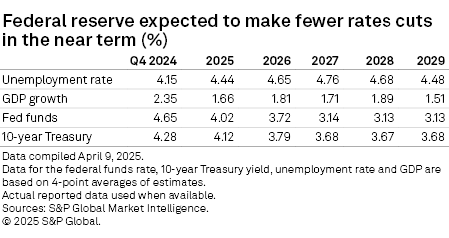
This article was published by S&P Global Market Intelligence and not by S&P Global Ratings, which is a separately managed division of S&P Global.
S&P Global Commodity Insights produces content for distribution on S&P Capital IQ Pro.
